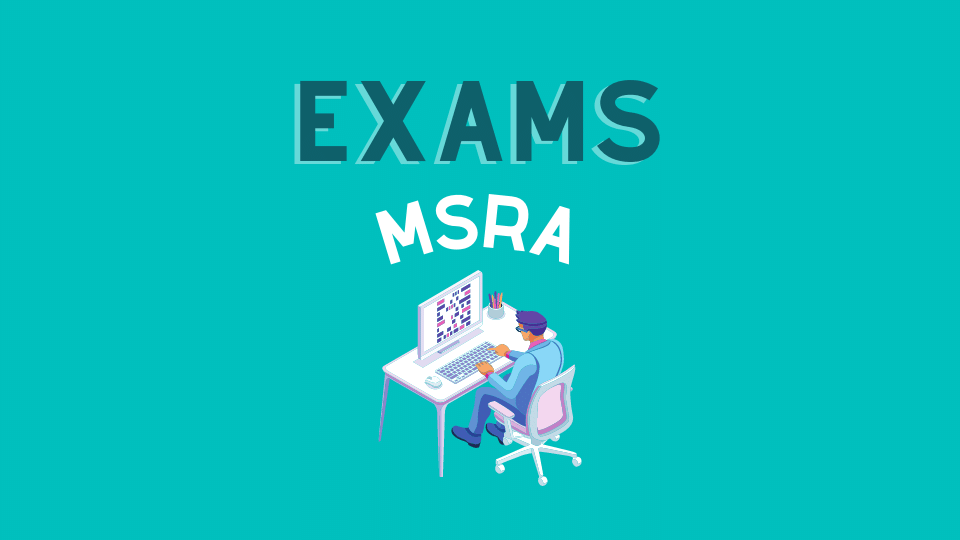MSRA Study Tips
Dear Friend,
I hope you’re enjoying the warmer weather we’ve had recently. I’m currently in the middle of an 11-day stretch of shifts at work and looking forward to a much-needed Easter weekend break. I’m also eagerly awaiting the outcome of my oncology ST3 application, which is expected early next week. I am equally excited and nervous as I look ahead to this next chapter.
While I preparing for my ST3 interviews, I also had friends who were preparing for the MSRA exams, which now serves as the entry point for CT1/ST1 training in all specialties, except for Paediatrics and IMT. While some of my friends secured top offers in their chosen specialties, others unfortunately didn’t get their preferred locations or specialties. Although it seems unfair that one exam holds such weight, I thought I’d share a few strategies for exam preparation that have helped me in the past.

Understanding Core Concepts Over Rote Learning
The MSRA was initially introduced to determine rankings for GP applications, covering the basics of all specialties and creating a broad syllabus. Most candidates are familiar with one or two subjects, but unless they’ve recently completed medical school, they tend to forget the core concepts.
It’s tempting to rely on MCQ banks and memorize answers based on the explanations, but this approach doesn’t foster real understanding. If the question is worded differently, you may struggle. I always recommend focusing on truly understanding the concepts.
I understand that covering such a vast syllabus can be overwhelming, but I suggest using my medical textbook The Revision Guide to Core Clinical Medicine, a concise resource that covers Anatomy, Physiology, Pharmacology, Disease Pathology, and Treatment. It was designed to help final-year medical students and junior doctors grasp core concepts and is based on notes I compiled from my own studies.
Allowing Yourself The Luxury of Time
Most people I spoke with set aside the last 2-3 months for exam preparation while balancing full-time jobs and personal responsibilities. While this might work for some, given the high stakes of the MSRA, I don’t recommend leaving your preparation until the last minute. If you’re aiming for a training position, you likely decided months ago. Why not start preparing earlier?
Give yourself 7-8 months to study, absorb the material, and still enjoy guilt-free breaks. This approach will put you in the right mindset for revision and enhance your ongoing clinical practice, ultimately making you a more confident doctor.
Making Notes
During your preparation, you’ll identify weak areas—this is normal. Recognize them, write them down, and review them regularly. I always create an LMR (Last Minute Revision) sheet to track topics I tend to forget or frequently get wrong. I also use this document to note key concepts (clinchers) that are crucial for answering questions efficiently. Time management is critical during the exam, so you’ll need to skim questions, spot key clues, and answer confidently.
Similarly, I know someone who keeps a Wrong Diary – which she uses as a powerful tool for turning mistakes into learning opportunities. When you take a mock test, you’re not just assessing your knowledge; you’re exposing areas that need attention. The goal is to transform each error into a future success. In a high-stakes exam like the MSRA, precision is far more important than perfection.
Practicing with Mocks
As I mentioned earlier, no matter how well you know the material, poor time management can undermine your performance. The best way to improve is by practicing with timed mock exams. This will help you develop the skill to navigate questions quickly, identify clinchers, and eliminate incorrect options.
Mock exams also highlight weak spots, which can then be added to your LMR sheet or Wrong Diary. Most importantly, practicing mocks reduces the uncertainty you may feel during the actual exam.
Resources to Use
It’s important to find what works best for you—there’s no one-size-fits-all approach. No MCQ resource is definitively better than another.
The MSRA consists of two parts:
1. Clinical Problem Solving
Popular MCQ Banks:
– PassMedicine
– EMedica
– ReviseMSRA
– MCQBank
– Samson
2. Professional Dilemmas
This is where many people struggle, and I recall the difficulty of Situational Judgment Tests (SJTs) from my foundation year exams. Although many question banks include SJT practice questions, I’ve spoken to trainees who recommend caution. These unofficial question banks are helpful, but not definitive.
I suggest reading Good Medical Practice and solving mocks provided by UKFPO or HEE MSRA, as these are the most reliable sources. The key is to solve, revisit, and internalize the rationale behind the answers, helping you think in the way the NHS expects.
Final Thoughts
Don’t get caught up in the debate over which resources to use. In the end, they all convey the same information. What matters most is what you retain.
I hope these strategies help those of you preparing for the MSRA. Best of luck!
Drug of the week
Pamidronate
Pamidronic acid is a nitrogen-containing bisphosphonate used to prevent osteoporosis.
By binding to hydroxyapatite crystals within bone, it downregulates osteoclast-mediated bone reabsorption, thereby leading to a reduction in bone matrix breakdown
It is also used to strengthen bone in Paget’s disease, to prevent bone loss due to steroid use, and in certain cancers with high propensity to bone, such as multiple myeloma.

A Brain Teaser
A 55-year-old man presents with haematuria and right-sided loin pain. A CT scan of the abdomen reveals an 8 cm mass in the upper pole of the right kidney with no evidence of lymph node involvement or distant metastases. The patient has a history of well-controlled hypertension and is otherwise healthy.
What is the most appropriate management?
A: Active surveillance
B: Partial nephrectomy
C: Radical nephrectomy
D: Radiotherapy
E: Tyrosine kinase inhibitor therapy
Answers
The answer is C – radical nephrectomy
The correct answer is radical nephrectomy. Haematuria, abdominal mass, and loin pain are the classical triad of symptoms seen in renal cell carcinoma (RCC). RCC accounts for 85% of renal cancers and most commonly affects middle-aged men.
The management of RCC depends on the T category. T1 tumours are treated with a partial nephrectomy, and T2 with radical nephrectomy (as in this case). T3 and T4 tumours are typically managed surgically with a radical nephrectomy if resectable. Systemic therapies like tyrosine kinase inhibitors are considered for metastatic or unresectable RCC. RCC is typically resistant to radiotherapy and chemotherapy, so these play no role in the management of RCC.
Active surveillance is incorrect. Active surveillance is typically reserved for small renal masses (< 4 cm) in patients with significant comorbidities or those who are not eligible for surgery (e.g. frail patients). Given the size of the tumour and the patient’s overall health, this is not the best option.
Partial nephrectomy is incorrect. A partial nephrectomy is generally considered for smaller tumours (< 7 cm) or when preservation of renal function is critical. However, given the tumour size (8 cm), a radical nephrectomy is preferred.
Radiotherapy is incorrect. Radiotherapy is not a standard treatment for primary renal cell carcinoma due to its limited effectiveness in controlling the primary tumour. It may be used for palliation in cases of metastatic disease, but it is not appropriate for this patient with localised disease.
Tyrosine kinase inhibitor therapy is incorrect. Agents such as tyrosine kinase inhibitors are generally used for metastatic renal cell carcinoma. Since there is no evidence of metastasis in this patient, this is not the appropriate first-line treatment.




